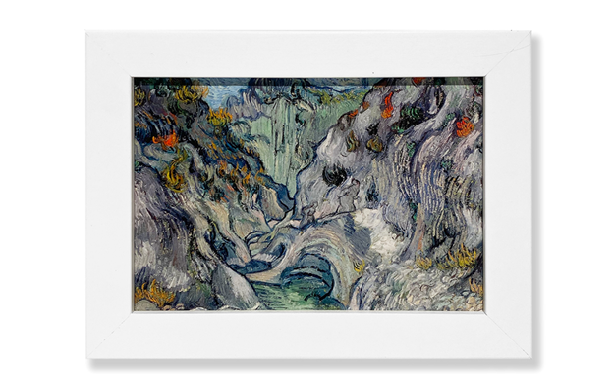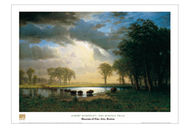How to Frame and Hang Museum Art Prints in Your Home: A Complete Guide
Jun 19th 2025
Decorating with museum art prints can bring elegance, culture, and a personal touch to your living space. However, to truly do justice to these pieces, careful consideration must be given to how you frame and hang them.
From placement and lighting to frame selection and wall compatibility, each decision affects how the art is perceived. This comprehensive guide will walk you through everything you need to know to frame and hang our museum art poster prints like a professional.
Understanding the Art Itself
Before making framing or placement decisions, take a moment to consider the nature of the print:
- Medium and Paper: Is it a lithograph, giclée, or offset print? What type of paper is it printed on—matte, glossy, textured?
- Color Palette: Will bold hues benefit from a minimalist frame or mat? Do pastels need warmth or contrast?
- Subject and Style: Classical art may call for ornate frames; minimalist modern art may demand sleek, simple borders. While it’s often a matter of personal choice, the look and texture of a frame does play a role in how a print (or painting for that matter) is presented.
Choosing the Right Frame
Materials:
- Wood Frames: Offer warmth and traditional appeal. Ideal for classic prints or portraits. There are also a wide variety of different kinds of woods to choose from when it comes to frames, as well as different degrees of detailing.
- Metal Frames: Sleek and minimal. Great for modern, abstract, or black-and-white pieces.
- Acrylic or Plexiglass Frames: Lightweight and often used in contemporary settings.
Color and Finish:
- Black: Bold and formal; ideal for monochrome or high-contrast art.
- White: Clean and subtle; makes colorful prints pop.
- Natural Wood: Inviting and versatile; works with most color palettes.
- Gold/Silver: Adds elegance and is often used for reproductions of Renaissance or Baroque art.
Frame Width:
- Thicker frames create a bold presence; thinner frames are more delicate and understated.
- Balance frame width with artwork size: a large print can handle a wider frame.
Matting: To Mat or Not to Mat?
- Purpose of a Mat:
- Adds breathing room between the artwork and the frame.
- Prevents the artwork from touching the glass.
- Elevates the overall presentation.
- Types of Mats:
- Single Mat: Clean and classic.
- Double Mat: Adds depth and complexity.
- Float Mounting: Artwork appears to “float” above the matboard—great for textured or deckled-edge prints.
- Mat Color:
- Neutral tones (white, ivory, gray) are safest and museum-friendly.
- Colored mats can accent hues in the print but must be used carefully to avoid distraction.
Glass and Glazing Options
- Standard Glass: Affordable but can produce glare and offer limited UV protection.
- Non-Glare Glass: Diffuses reflections but may dull the image slightly.
- UV-Protective Glass: Prevents fading from sunlight exposure.
- Museum Glass: The best option: low-reflection and high UV protection.
If your art is valuable or irreplaceable, investing in museum-grade glass is worth the cost.
In case you aren’t interested in this part of the process, we have a lovely collection of framed art prints here in our museum store. These come framed and have glass as well, so all of the guesswork is taken away for you.

Placement and Positioning
Ideal Height:
- Gallery Rule: Center of the artwork should be about 57–60 inches from the floor (eye level). This will ensure that you’re looking at the artwork at the ideal angle.
- Adjust from there based on ceiling height, furniture, and viewer preference.
Room-by-Room Tips:
- Living Room: Place above a sofa or fireplace, centered and proportional. Large framed prints in strategic locations in your living room (or similar spaces like family rooms) create visual interest and make the spaces feel richer.
- Bedroom: Smaller prints work well in groupings; avoid direct overhead pieces unless securely anchored.
- Hallways: Create a gallery-style lineup of smaller pieces for visual interest.
- Dining Room: Large, bold prints work well, especially on expansive walls.
Wall Compatibility:
- Make sure your wall type (drywall, plaster, brick) supports the weight of your frame.
- Use the appropriate hardware—wall anchors, hooks, or picture-hanging systems.
Lighting Considerations
Lighting plays a critical role in art presentation. Without the right lighting, an art print might look dull (too little lighting) or washed out (too much lighting). There is also the preservation of the print to consider.
Natural Light:
- Avoid direct sunlight, which can cause fading even with UV protection.
- Diffused natural light is ideal.
Artificial Lighting:
- Track Lighting: Popular in galleries; can be directed at specific works.
- Picture Lights: Mounted above frames to highlight art; choose LED for low heat and energy efficiency.
- Recessed Lighting: Elegant and non-intrusive; avoid casting shadows.
Light Temperature:
- Use warm white (2700K–3000K) bulbs for most art. Cooler temps can flatten warmer color palettes.
Gallery Wall Layout Tips
If you are working with more than one art print and want to get creative, here are some suggestions:
- Symmetrical Grid: Classic and formal. Ideal for uniform prints.
- Salon Style: Eclectic and layered. Great for mixing frame types and sizes.
- Linear Arrangement: Clean and contemporary. Use a consistent center line.
- Anchor Piece + Surround: Choose one large artwork to anchor the wall, surrounded by smaller prints.
Use paper templates or painter’s tape to plan layout before hanging, that way you have a decent idea of how everything will look beforehand.

Tools & Hardware Checklist
- Measuring tape
- Level
- Pencil for marking
- Picture hanging hooks or wall anchors
- Hammer or drill
- Command strips (for lighter or rental-safe solutions
- Wire hanging kits for heavy frames
Always double-check weight limits and wall compatibility before hanging.
Conservation & Care
- Keep art prints away from heat sources, such as radiators or vents.
- Avoid hanging in bathrooms due to humidity unless prints are sealed and glass is moisture-resistant.
- Dust frames and glass with a microfiber cloth.
- Periodically check wire and hanging hardware for wear.
Fill Your Home With Art
Framing and hanging museum art prints is an art in itself. The right frame complements the piece, the right placement enhances its presence, and the right lighting brings it to life. Whether you're curating a personal gallery or spotlighting a single treasured piece from our collection, these thoughtful details will ensure your art is admired, protected, and harmoniously integrated into your space.
For bonus impact, consider rotating prints seasonally, adding wall labels with artist bios, or integrating your collection into themed interior design concepts. Art is an expression of culture, memory, and soul. Frame it accordingly.
If you are looking for beautiful art posters to hang in your home, take a look through our selection here at the Museum of Fine Arts, Boston.

